RNA-seq-based digital gene expression analysis reveals modification of host defense responses by rice stripe virus during disease symptom development in Arabidopsis
- PMID: 27912765
- PMCID: PMC5134058
- DOI: 10.1186/s12985-016-0663-7
RNA-seq-based digital gene expression analysis reveals modification of host defense responses by rice stripe virus during disease symptom development in Arabidopsis
Abstract
Background: Virus infection induces and suppresses host gene expression on a global level. Rice stripe virus (RSV) is the type species of the genus Tenuivirus and infects rice and Arabidopsis plants. Microarray-based and next generation sequencing-based transcriptomic approaches have been used to study rice-RSV interactions. However, our knowledge of the response of Arabidopsis plants to RSV infection is limited, and it requires further investigation to determine the similarities (or differences) in virus-host interactions between monocot and dicot hosts infected with RSV.
Methods: We characterized transcriptome changes in Arabidopsis thaliana infected with rice stripe virus (RSV) with RNA-seq based digital gene expression (DGE) analysis. The transcriptomes of RSV-infected samples were compared to those of mock-treated samples at 14 and 21 days post-infection (dpi) during different stages of symptom development.
Results: We identified 624 differentially expressed genes (DEGs) in Arabidopsis influenced by RSV at 14 dpi and 21 dpi, among which at 14 dpi, 255 transcripts were induced, and 38 were repressed; at 21 dpi, 146 were induced, and 237 were repressed. Functional annotation indicated that these DEGs were related to multiple biological functions, including defense response, secondary metabolism, protein amino acid phosphorylation and response to abiotic stress.
Conclusions: Importantly, the transcription of genes related to host defense systems was activated by RSV infection at an early stage of symptom development (14 dpi), whereas over the infection period (21 dpi), the host defense response systems were suppressed. A total of 52 genes were continuously differentially expressed between the two time points, indicating that the majority of DEGs were transient and unique to a particular time point during symptom development. The DEGs, particularly the defense response genes, identified in this study are candidates suitable for further functional analysis during the RSV-Arabidopsis interaction.
Keywords: Defense response; Digital gene expression (DGE); RNA-seq; Rice stripe virus.
Figures
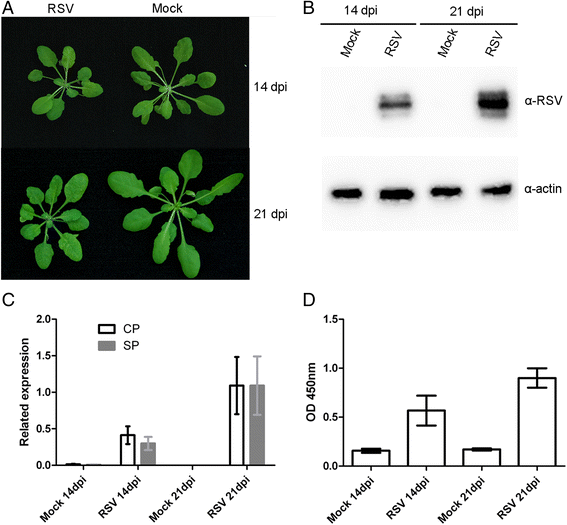
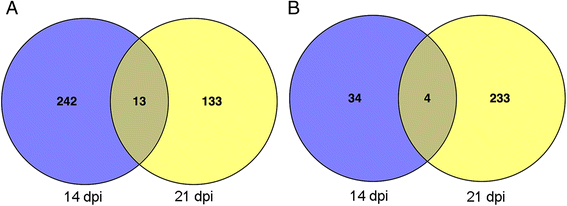
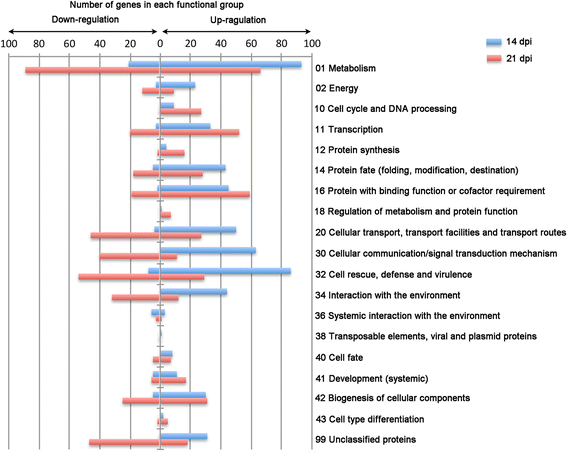
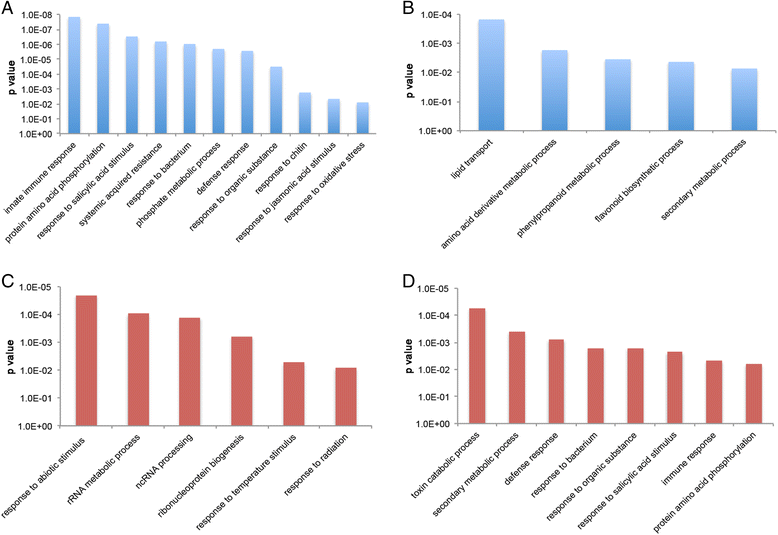
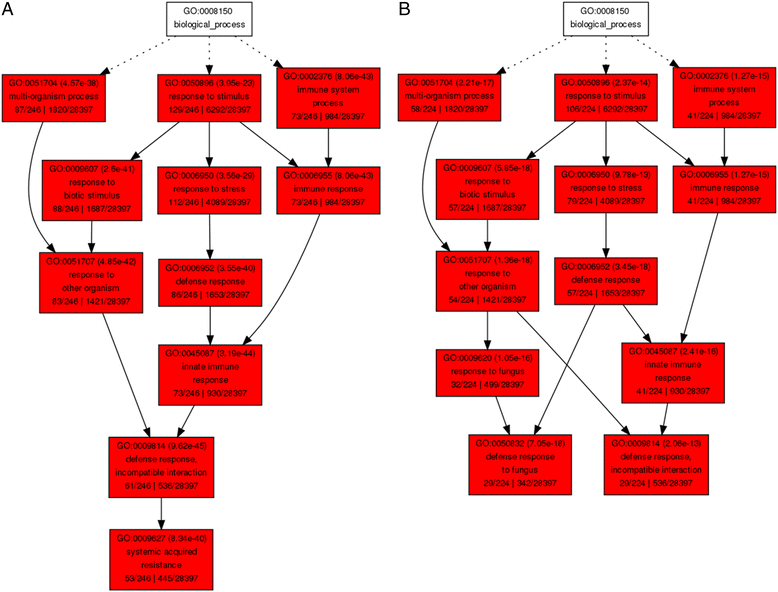
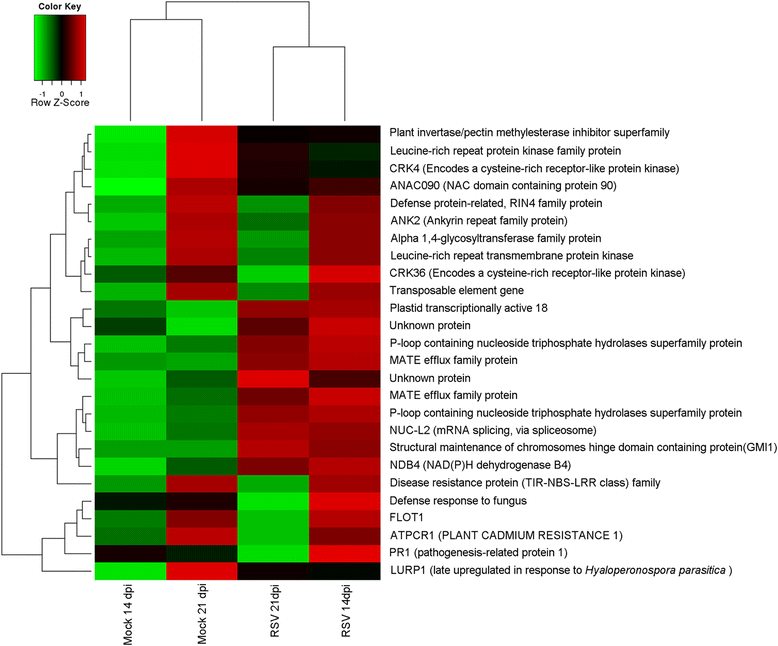
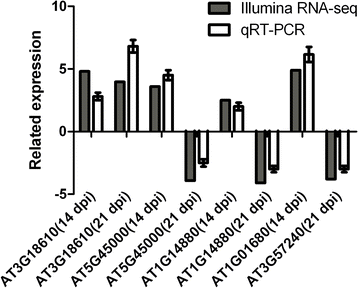
Similar articles
-
Time-Course RNA-Seq Analysis Reveals Transcriptional Changes in Rice Plants Triggered by Rice stripe virus Infection.PLoS One. 2015 Aug 25;10(8):e0136736. doi: 10.1371/journal.pone.0136736. eCollection 2015. PLoS One. 2015. PMID: 26305329 Free PMC article.
-
Integrative Analysis of the microRNAome and Transcriptome Illuminates the Response of Susceptible Rice Plants to Rice Stripe Virus.PLoS One. 2016 Jan 22;11(1):e0146946. doi: 10.1371/journal.pone.0146946. eCollection 2016. PLoS One. 2016. PMID: 26799317 Free PMC article.
-
Selective modification of rice (Oryza sativa) gene expression by rice stripe virus infection.J Gen Virol. 2010 Jan;91(Pt 1):294-305. doi: 10.1099/vir.0.015990-0. Epub 2009 Sep 30. J Gen Virol. 2010. PMID: 19793907
-
Current Insights into Research on Rice stripe virus.Plant Pathol J. 2013 Sep;29(3):223-33. doi: 10.5423/PPJ.RW.10.2012.0158. Plant Pathol J. 2013. PMID: 25288949 Free PMC article. Review.
-
If it transcribes, we can sequence it: mining the complexities of host-pathogen-environment interactions using RNA-seq.Curr Opin Microbiol. 2017 Apr;36:37-46. doi: 10.1016/j.mib.2017.01.010. Epub 2017 Feb 10. Curr Opin Microbiol. 2017. PMID: 28189909 Review.
Cited by
-
Differential gene expression and physiological changes during acute or persistent plant virus interactions may contribute to viral symptom differences.PLoS One. 2019 May 3;14(5):e0216618. doi: 10.1371/journal.pone.0216618. eCollection 2019. PLoS One. 2019. PMID: 31051010 Free PMC article.
-
AtGSTU19 and AtGSTU24 as Moderators of the Response of Arabidopsis thaliana to Turnip mosaic virus.Int J Mol Sci. 2022 Sep 29;23(19):11531. doi: 10.3390/ijms231911531. Int J Mol Sci. 2022. PMID: 36232831 Free PMC article.
-
Rice Stripe Virus Coat Protein-Mediated Virus Resistance Is Associated With RNA Silencing in Arabidopsis.Front Microbiol. 2020 Nov 13;11:591619. doi: 10.3389/fmicb.2020.591619. eCollection 2020. Front Microbiol. 2020. PMID: 33281789 Free PMC article.
-
Transcriptomic profile of tobacco in response to Tomato zonate spot orthotospovirus infection.Virol J. 2017 Aug 14;14(1):153. doi: 10.1186/s12985-017-0821-6. Virol J. 2017. PMID: 28807054 Free PMC article.
-
Comparison of LncRNA Expression Profiles during Myogenic Differentiation and Adipogenic Transdifferentiation of Myoblasts.Int J Mol Sci. 2019 Jul 30;20(15):3725. doi: 10.3390/ijms20153725. Int J Mol Sci. 2019. PMID: 31366088 Free PMC article.
References
Publication types
MeSH terms
LinkOut - more resources
Full Text Sources
Other Literature Sources

